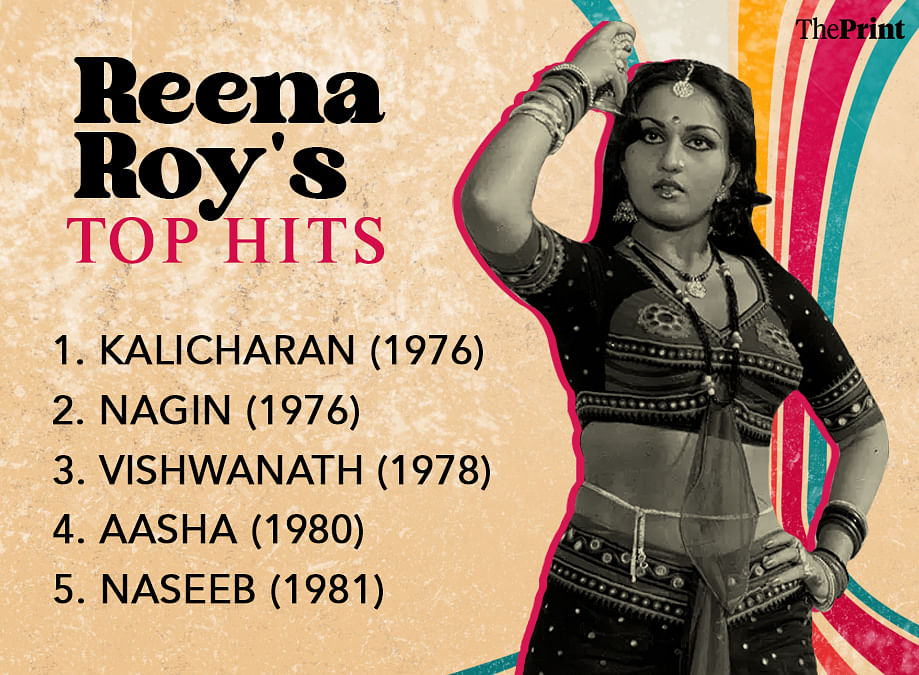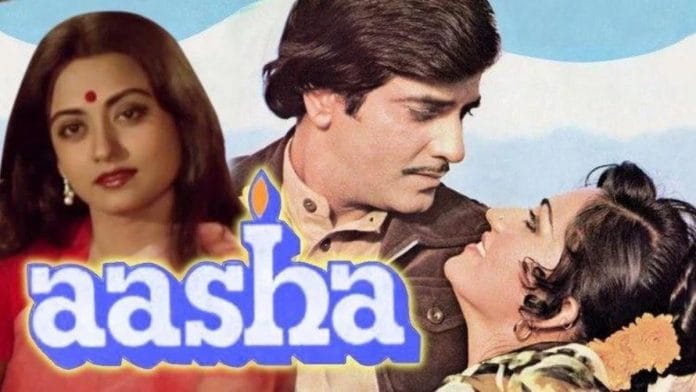N[obody does melodrama as well as Bollywood. And in the 1980s, the anthem for heartbroken lovers was ‘Sheesha Ho Ya Dil Ho’ from the Aasha, where Lata Mangeshkar compares the heart with a piece of glass—both can shatter easily.
In the 1980 movie, Reena Roy, who plays a popular singer Aasha performs the song in a shimmery black sharara set. Roy later said that she copied Mangeshkar’s mannerisms for the performance, which included the way the singer used to cough between the song’s recordings. The song, which plays twice in the film, encapsulates the heartbreak Aasha suffers as she helps the love of her life, Deepak (Jeetendra) reunite with his missing wife Mala (Talluri Rameswari)—at the expense of her own happiness.
It’s the ultimate noble act by the ‘other’ woman—one that viewers wholeheartedly approved of. Directed by J Om Prakash, Aasha, was a blockbuster. It was the second-highest-grossing movie of the year.
It was remade in Telugu (Anuraga Devatha) and Tamil (Sumangali).
It is also the first screen appearance of Om Prakash’s grandson, Hrithik Roshan. Forty years before his breakout film as an adult in Kaho Naa Pyaar Hai (2000), six-year-old Roshan was one of the extras dancing during the song ‘Jane Hum Sadak Ke Log’ in Aasha.
He was not credited for it, but reportedly received Rs 100 from his grandfather for his dance performance.
Also read: ‘Mashaal’ mixed news media with melodrama. It made Anil Kapoor an ‘A-grade hero’
Complex female characters
True to Prakash’s signature filmmaking style, Aasha allowed the actors to run through the gamut of emotions from the height of ecstasy to the depths of despair.

The plot follows a chance meeting between a truck driver Deepak (Jeetendra), and a famous singer Aasha. While Deepak tells Aasha about his fiance, Mala (Rameshwari), Aasha realises she too has fallen for him. But she addresses him as dost (friend), and they part ways amicably.
Deepak marries Mala, but soon a catastrophic event forces the two lovers apart. Each thinks the other is dead, and tries to move on with their lives. This is when Aasha re-enters Deepak’s life. But when all the misunderstandings are finally cleared, Aasha has to make a tough decision.
Her character is complex and empathetic—something female characters in Om Prakash movies have in common.
In his directorial debut, Aap Ki Kasam (1974), starring Rajesh Khanna and Mumtaz, the woman decides to leave her marriage when her husband’s unfounded suspicions of her having an affair turn their marriage toxic. Even in this film, Roy’s character takes the moral high round.
Prakash’s films always relied on exceptional music to push forward the emotional core of the film. He worked with a particular set of people that included superstars Rajesh Khanna and Jeetendra, and music directors Laxmikant-Pyarelal and Shankar Jaikishan.
Also read: ‘Ankhiyon Ke Jharokhon Se’ was a remake of an American novel. Here, parents aren’t villains
All about melodrama
The melodramatic elements in the movie are heightened by sequences of continuous misfortunes that befall Deepak and Mala. It’s like a Thomas Hardy tragedy. After Deepak is presumed dead, his mother blames Mala for bringing ‘bad luck’ to the family. She leaves her husband’s house, only to deal with her father’s passing.
Alone and abandoned, and with her mother-in-law’s words ringing in the background, Mala decides to end her life. She survives, but loses her eyesight.
This was a familiar trope in most melodramatic movies from the 1970s and 1980s. In Mere Jeevan Saathi (1972) Prakash (Rajesh Khanna) loses his eyesight and it leads to a complicated love triangle.
In Amar Akbar Anthony (1977), Bharati (Nirupa Roy) loses her eyesight and never realises that one of her estranged sons is taking care of her as an adult.
Mala gets her happy ending in Aasha. She regains her sight and is reunited with Deepak.
The dialogue also adds to the melodrama. Everyone speaks in rhymes and hyperboles. In one of the earlier scenes in the film, Aasha declares, my life is a show, when Deepak merely inquires if she has a musical show in the evening.
Also read: Sai Paranjpye’s ‘Sparsh’ squashes the ‘lachar-bechara’ image of blind people
Unrequited love
Aasha was one of the most successful films in Roy’s career. While the trope of the unrequited male lover has been ubiquitous not just in Hindi cinema, but across languages, not many depictions of their female counterparts exist. They are often relegated to conniving vamps or a ‘side character’.
Aasha stands out for its titular role played by Roy. She got a chance to prove her mettle with the many changes her character goes through—from a successful singer to a woman in love to later, the self-effacing and ‘sacrificing’ friend.
There’s an easy chemistry between her and Jeetendra–the two had already worked together successfully in films like Nagin (1976) and Udhar Ka Sindur (1976).
For Rameswari, the film was a precursor to the kind of roles she would eventually take up on TV, of a helpless woman, grieving the misfortunes that have befallen her.
(Edited by Theres Sudeep)






